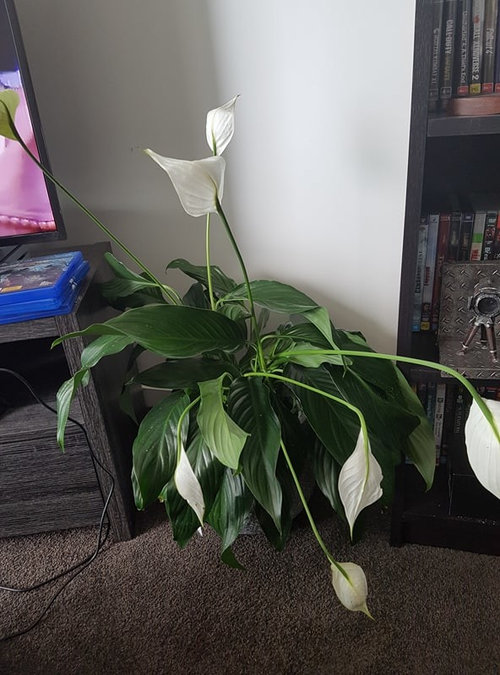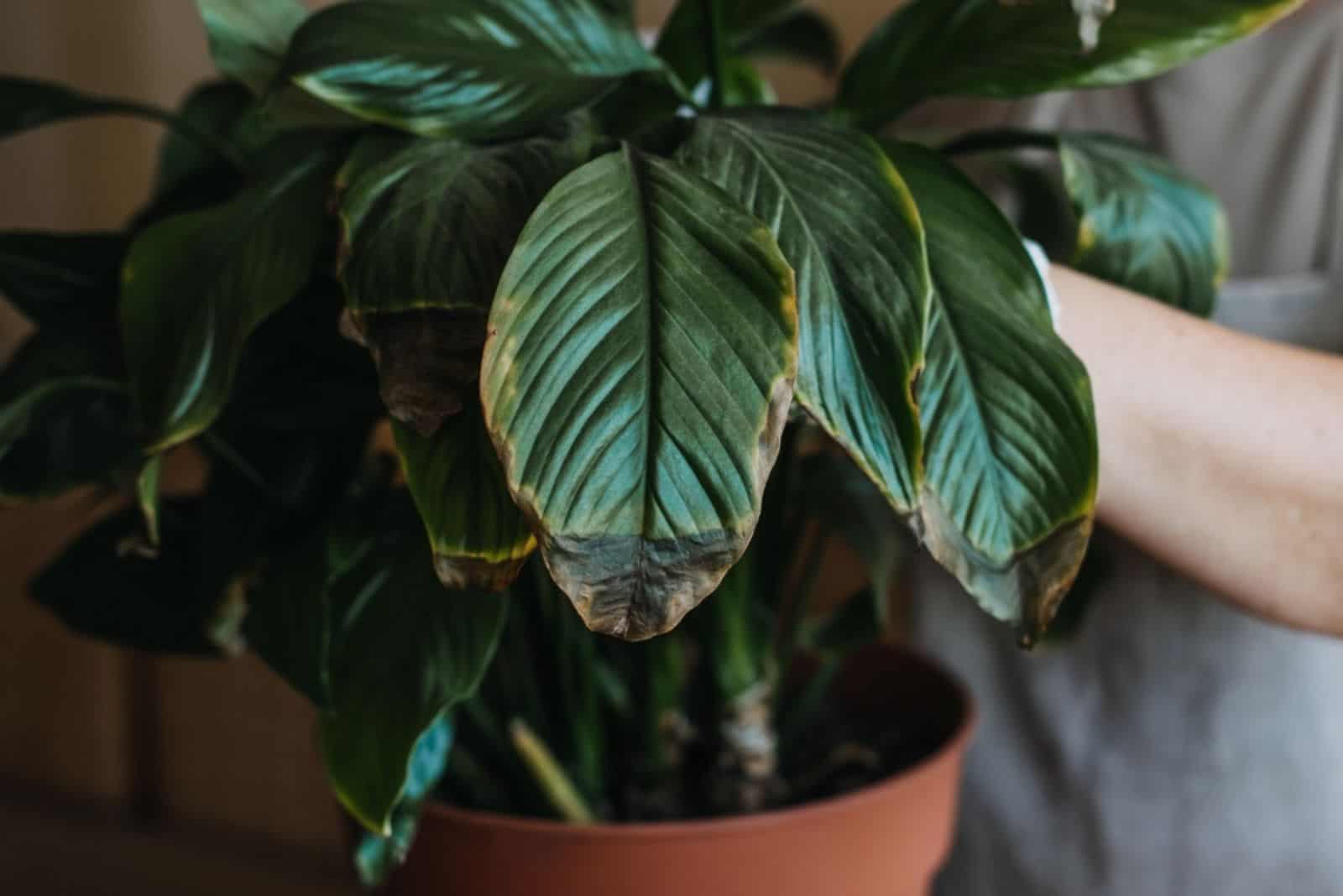Identifying the Problem: Is Your Peace Lily in Distress?
Monitoring your peace lily’s health is crucial to prevent minor issues from escalating into major problems. If you’re wondering what’s wrong with your peace lily, the first step is to recognize the early signs of trouble. These can include yellowing leaves, droopy stems, or a lack of growth. By catching these issues early, you can take corrective action and prevent more severe problems from developing.
Peace lilies are relatively low-maintenance plants, but they still require attention and care. Neglecting your plant’s needs can result in a range of problems, from pest infestations to nutrient deficiencies. By staying vigilant and addressing issues promptly, you can ensure your peace lily remains healthy and thriving.
Regularly inspecting your peace lily can help you identify potential problems before they become severe. Check for signs of stress, such as yellowing or droopy leaves, and take action to address the underlying cause. This proactive approach can help you prevent common issues and keep your peace lily happy and healthy.
Overwatering: The Most Common Cause of Peace Lily Problems
Overwatering is a common mistake that can have devastating consequences for your peace lily. When the soil is consistently waterlogged, the roots can rot, leading to fungal infections and nutrient deficiencies. If you’re wondering what’s wrong with your peace lily, overwatering could be the culprit. It’s essential to recognize the signs of overwatering, including yellowing leaves, soft stems, and a generally weak appearance.
To avoid overwatering, it’s crucial to check the soil moisture regularly. Stick your finger into the soil up to the first knuckle, and if the soil feels dry, it’s time to water. If it’s already moist, wait a few more days before watering again. Adjust your watering schedule according to the season, as peace lilies require more water during the spring and summer months when they’re actively growing.
Another way to prevent overwatering is to ensure good drainage in the pot. Use a well-draining potting mix and a pot with drainage holes to prevent water from accumulating in the soil. By taking these precautions, you can prevent overwatering and keep your peace lily healthy and thriving.
How to Revive a Peace Lily from Underwatering
If you’re wondering what’s wrong with your peace lily and suspect underwatering, don’t worry – it’s not too late to revive your plant. Underwatering can cause peace lilies to become stressed, leading to yellowing leaves, droopy stems, and a general decline in health. However, with proper care and attention, you can help your peace lily recover.
First, increase the humidity around your peace lily by placing the pot on a tray filled with water and pebbles or using a humidifier. This will help the plant absorb moisture more efficiently. Next, provide indirect sunlight, as direct sunlight can cause further stress to the plant. East- or west-facing windows are ideal for peace lilies.
Fertilizing your peace lily is also crucial to its recovery. Use a balanced, water-soluble fertilizer and follow the instructions on the label. Avoid overfertilizing, as this can cause more harm than good. By providing the right amount of moisture, light, and nutrients, you can help your peace lily recover from underwatering and thrive once again.
Pests and Diseases: Uninvited Guests in Your Peace Lily’s Home
If you’re wondering what’s wrong with your peace lily, pests and diseases could be the culprits. Peace lilies are susceptible to various pests and diseases that can cause significant damage if left untreated. Common pests that affect peace lilies include spider mites, mealybugs, and scale. These pests can cause yellowing leaves, white powdery residue, and a general decline in plant health.
To identify pest infestations, inspect your peace lily regularly for signs of pests. Check the undersides of leaves and stems for eggs, larvae, or actual pests. If you find any, treat your peace lily with insecticidal soap or neem oil according to the product’s instructions.
Diseases such as root rot, leaf spot, and crown rot can also affect peace lilies. These diseases are often caused by overwatering, poor air circulation, and high humidity. To prevent diseases, ensure good air circulation around your peace lily, avoid overwatering, and remove any dead or dying leaves and stems.
If you suspect your peace lily has a disease, isolate it from other plants to prevent the spread of the disease. Treat the plant with a fungicide specifically designed for houseplants, and adjust its care routine to prevent further infection.
Nutrient Deficiencies: The Hidden Cause of Peace Lily Problems
If you’re wondering what’s wrong with your peace lily, nutrient deficiencies could be the answer. Peace lilies require a balanced diet of nutrients to thrive, and a lack of essential nutrients can cause a range of problems, from yellowing leaves to stunted growth.
Nitrogen deficiency is a common issue in peace lilies, causing yellowing leaves and stunted growth. Iron deficiency can cause yellowing leaves with green veins, while magnesium deficiency can lead to yellowing leaves and a general decline in plant health.
To identify nutrient deficiencies, inspect your peace lily’s leaves and stems regularly. Look for signs of yellowing, browning, or curling, which can indicate a lack of essential nutrients. If you suspect a nutrient deficiency, fertilize your peace lily with a balanced, water-soluble fertilizer.
When fertilizing, follow the instructions on the label and avoid overfertilizing, which can cause more harm than good. It’s also essential to fertilize at the right time, as peace lilies have different nutrient requirements during different stages of growth.
By providing your peace lily with the right nutrients, you can help it thrive and prevent common problems. Remember, a healthy peace lily is a happy peace lily, and with proper care and attention, you can enjoy its beautiful blooms and elegant foliage for years to come.
Lighting Issues: Finding the Perfect Spot for Your Peace Lily
If you’re wondering what’s wrong with your peace lily, lighting issues could be the culprit. Peace lilies require the right amount of light to thrive, and insufficient or excessive light can cause a range of problems, from yellowing leaves to stunted growth.
Peace lilies prefer bright, indirect light, but not direct sunlight. Direct sunlight can cause the leaves to become scorched and the plant to become stressed. East- or west-facing windows are ideal for peace lilies, as they provide gentle, indirect light.
If you don’t have a suitable window, you can supplement with artificial lighting. Fluorescent lights or LED grow lights can provide the necessary light for your peace lily. However, be careful not to overdo it, as too much artificial light can also cause stress.
To determine the best location for your peace lily, observe the light in your home. Take note of the time of day and the intensity of the light. If you’re still unsure, you can use a light meter to measure the light levels.
By providing your peace lily with the right amount of light, you can help it thrive and prevent common problems. Remember, a happy peace lily is one that receives the right amount of light, water, and nutrients.
Temperature Extremes: Protecting Your Peace Lily from Heat and Cold
If you’re wondering what’s wrong with your peace lily, temperature extremes could be the culprit. Peace lilies are sensitive to temperature fluctuations, which can cause a range of problems, from yellowing leaves to stunted growth.
Ideal temperatures for peace lilies range from 65°F to 80°F (18°C to 27°C). Temperatures above 80°F can cause heat stress, while temperatures below 55°F can cause cold stress. Avoid placing your peace lily near heating or cooling vents, fireplaces, or drafty windows.
To maintain a consistent temperature range, keep your peace lily away from extreme temperatures. If you live in an area with cold winters, bring your peace lily indoors during the winter months. In hot summer months, provide shade or air conditioning to keep the temperature in check.
Drafts can also cause temperature fluctuations, so make sure to protect your peace lily from cold air. You can do this by placing the pot on a tray filled with water and pebbles or by using a humidifier to maintain a consistent humidity level.
By protecting your peace lily from temperature extremes, you can help it thrive and prevent common problems. Remember, a happy peace lily is one that receives the right amount of light, water, and nutrients, and is protected from extreme temperatures.
Pruning and Grooming: Keeping Your Peace Lily Happy and Healthy
If you’re wondering what’s wrong with your peace lily, poor pruning and grooming habits could be the culprit. Regular pruning and grooming are essential to promote healthy growth and prevent common problems.
Start by removing any dead or dying leaves and stems. This will help prevent the spread of disease and encourage new growth. Use clean, sharp scissors or pruning shears to avoid spreading bacteria or fungi.
Next, inspect your peace lily for any signs of overcrowding. If the plant is pot-bound, consider transplanting it into a larger pot with fresh, well-draining soil. This will give the roots more room to grow and help prevent waterlogged soil.
Pruning can also help control the shape and size of your peace lily. Remove any leggy stems or yellowing leaves to maintain a bushy, compact shape. This will also encourage the plant to produce more blooms.
In addition to pruning, regular grooming can help keep your peace lily healthy. Dust the leaves with a soft-bristled brush to remove any dirt or debris. This will help prevent pests and diseases from taking hold.
By incorporating regular pruning and grooming into your care routine, you can help keep your peace lily happy and healthy. Remember, a well-maintained peace lily is less likely to experience common problems, such as yellowing leaves, droopy stems, or lack of growth.






